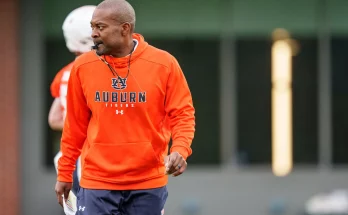College Football Analyst David Pollack Identifies Penn State, Texas, and Third Team as Major Contenders in Upcoming Season
David Pollack, renowned college football analyst and former Georgia Bulldogs defensive end, has once again weighed in on the competitive landscape of college football as the new season approaches. Drawing from his experience on the field and deep knowledge of the game, Pollack has identified the Penn State Nittany Lions and Texas Longhorns as two of the teams to watch closely this year. Alongside them, he points to another powerhouse program that he believes will play a significant role in shaping the championship conversation. His insights offer a compelling glimpse into the shifting tides of college football power and what fans can expect from these storied programs.
Pollack’s analysis carries weight given his storied history with Georgia and his keen eye for talent and strategy. As a former defensive end who made his mark in the Southeastern Conference (SEC) and went on to become a trusted voice in college football broadcasting, his assessments are followed closely by fans, players, and coaches alike. When Pollack singles out programs like Penn State and Texas, it signals that these teams possess a rare combination of talent, coaching acumen, and potential to disrupt the traditional balance of power.
The Penn State Nittany Lions have long been a respected program with a strong tradition of hard-nosed football and disciplined defense. Pollack highlights Penn State’s balanced approach this season, emphasizing their solid offensive line and dynamic skill players who can create explosive plays. The Nittany Lions’ coaching staff has shown an ability to adapt schemes to maximize the strengths of their roster, which Pollack believes will be a key factor in their success. He notes that if Penn State can maintain consistency, particularly in their running game and defensive stops, they have the tools to compete against any top-tier team.
Texas Longhorns, meanwhile, have been under intense scrutiny in recent years, with expectations to reassert themselves as a dominant force in college football. Pollack points to Texas’s blend of veteran leadership and incoming talent as a recipe for success. The Longhorns’ offense is expected to be high-powered, with a mix of experienced quarterbacks and playmakers who can stretch the field. On defense, Texas is building a squad that combines speed and physicality, which Pollack believes will challenge even the most formidable offenses. According to him, the Longhorns’ ability to execute under pressure and capitalize on key moments will determine their trajectory this season.
In his analysis, Pollack also mentions a third program—one that often finds itself in the spotlight during college football’s most critical moments. Though he stops short of naming them explicitly in every commentary, it is clear that he sees this team as a significant player in the national championship picture. This third team’s blend of tradition, coaching pedigree, and player development creates a competitive edge. Pollack emphasizes the importance of depth on both sides of the ball and the mental toughness required to navigate a grueling season filled with high-stakes matchups.
Pollack’s evaluation of these three programs underscores the increasing parity in college football. While conferences like the SEC and Big Ten have dominated headlines, teams from different regions are emerging as credible threats, expanding the field of championship contenders. This diversification of powerhouses contributes to a more unpredictable and thrilling season ahead, where preparation, adaptability, and resilience will be paramount.
His perspective also sheds light on the evolving recruiting landscape. Programs like Penn State and Texas have capitalized on expanding recruiting networks, tapping into rich talent pools across the country. Pollack suggests that this strategic recruitment, combined with strong player development programs, positions these teams to sustain success beyond just a single season. The ability to continually replenish rosters with high-caliber athletes is essential in maintaining a competitive edge, especially as the college football playoff system incentivizes consistent excellence.
Beyond roster talent, Pollack stresses the importance of coaching in molding these teams into contenders. Effective game planning, in-game adjustments, and fostering a culture of accountability and teamwork are critical. Pollack highlights the head coaches and key assistants for each program, noting their ability to develop players and build systems that align with their strengths. This leadership, according to Pollack, is often the differentiator in tight games and long seasons where mental toughness and strategic execution can determine outcomes.
From a tactical standpoint, Pollack points out certain strengths each team brings to the table. Penn State’s defense, traditionally stout against the run, is complemented by an offense that can adapt to various defensive looks. Texas boasts a high-tempo offense designed to wear down opponents, while their defense aims to create turnovers and pressure opposing quarterbacks. The unnamed third team, Pollack notes, combines a balanced offensive attack with a disciplined defensive approach, making them difficult to game plan against.
Pollack’s insights also touch on the broader implications for college football’s national title race. With these programs poised to challenge established powerhouses, the playoff picture is expected to be more dynamic. Upsets and unexpected outcomes could shape the narrative as the season progresses, keeping fans on the edge of their seats. Pollack suggests that the resilience of these teams in key rivalry games and conference matchups will be crucial in determining their playoff fate.
The enthusiasm surrounding these teams also highlights the growing fan engagement across college football. Pollack’s commentary fuels excitement among supporters, media, and analysts who eagerly anticipate how these programs will perform on game day. The narratives of rising stars, coaching battles, and strategic innovation create a compelling storyline that extends beyond the field, impacting recruiting, media coverage, and the overall popularity of the sport.
For players on these teams, Pollack’s endorsement serves as both recognition and motivation. Being identified as a key contender or part of a championship-caliber squad can galvanize athletes to elevate their performance. It also places a spotlight on individual players who may become pivotal in crucial moments, drawing attention from NFL scouts and national media alike. Pollack’s analysis often translates into increased visibility for players, which can influence their careers and the perception of their programs.
Looking ahead, Pollack’s assessment provides a framework for understanding the competitive dynamics that will shape the upcoming college football season. His identification of Penn State, Texas, and a third powerhouse program as major contenders invites fans and analysts to watch closely as these teams vie for supremacy. The blend of talent, coaching, and determination that Pollack highlights promises a season filled with thrilling contests, dramatic storylines, and memorable moments.
In conclusion, David Pollack’s insights reaffirm his reputation as a knowledgeable and respected voice in college football analysis. His spotlight on the Penn State Nittany Lions, Texas Longhorns, and another significant program adds depth to the national conversation about which teams are best positioned to compete for championships. As the season unfolds, Pollack’s observations will undoubtedly influence how fans, commentators, and participants view the race for college football’s ultimate prize. The anticipation is high, and the stakes are even higher, making this a season to watch closely.



